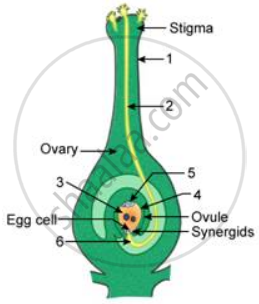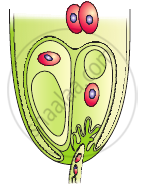Advertisements
Advertisements
प्रश्न
Given ahead is a diagrammatic representation of the process of fertilization. Study the same and then answer the question that follows:

Name the parts labelled 1, 2, 3, 4, 5 and 6.
उत्तर
1 → Style
2 → Pollen tube
3 → Polar nuclei
4 → Embryo sac
5 → Antipodal cells
6 → Micropyle
APPEARS IN
संबंधित प्रश्न
Double fertilization is reported in plants of both, castor and groundnut. However, the mature seeds of groundnut are non-albuminous and castor are albuminous. Explain the post fertilization events that are responsible for it.
Read the following statement and answer the questions that follow :
"A guava fruit has 200 viable seeds."
(a) What are viable seeds?
(b) Write the total number of :
(i) Pollen grains (ii) Gametes
in producing 200 viable guava seeds.
c) Prepare a flow-chart to depict the post-pollination events leading to viable-seed production in a flowering plant.
Fill in the blanks with suitable words.
Transference of pollen grains from anthers to stigma of the same flower is called ________.
Match the items in Column A with those in Column B.
|
Column A |
Column B |
|
(a) Generative nucleus |
(i) Pollen tube |
|
(b) Germ pore |
(ii) Endosperm nucleus |
|
(c) Exine |
(iii) Testa |
|
(d) Secondary nucleus |
(iv) Fertilization |
|
(e) Integument |
(v) Male nuclei |
|
(f) Egg nucleus |
(vi) Rough |
The seed is a fertilized _______.
Male gametes in angiosperms are formed by the division of ______.
Transmitting tissue is found in
Write a short note on Heterostyly.
Double fertilization is a distinctive feature of ______.
In the figure given below label the following parts: male gametes, egg cell, polar nuclei, synergid and pollen tube

